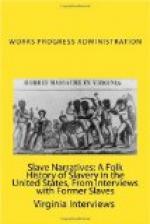Uncle Wes had been a “shut-in” for eleven months, and was in bed, but was cheerful and bright with an intelligent memory, rarely found in one his age. Uncle Wes tells me that he was born May 21, 1864 in Garrard County, near Cartersville, and was first a slave of Mrs. Eliza Kennedy, who later married John Yeakey, of that section of the county. “My father’s name was Ben Woods, my mother’s name was Janie Woods, but I do not know what family she belonged to except the Woods. My master owned about three or four hundred acres of land, and there were about twenty slaves, including the children.
There were three or four cabins for the slaves to live in, not so very far from the house. The cabin where my mother and father lived was the closest to the house, for my mother did the cooking. Our cabin was one long room, with a loft above, which we reached with a ladder. There was one big bed, with a trundle bed, which was on wooden rollers and was shoved under the big bed in the daytime. The oldest boys slept in a big wooden bed in the loft. The cabins were built of logs and chinked with rock and mud. The ceiling was of joists, and my mother used to hang the seed that we gathered in the fall, to dry from these joists. Some of the chimneys were made with sticks and chinked with mud, and would sometimes catch on fire. Later people learned to build chimneys of rock with big wide fire places, and a hearth of stone, which made them safer from fire.
Second Interview:
“I chopped corn and pulled weeds and the other work hands would let me ride behind them beck to the big house, and My! how hungry I wuz and how we did eat. We would have beans, cooked in a big kettle in the back yard, cabbage and potatoes, with corn pone bread, baked in a big oven In the yard and plenty of good buttermilk to drink.
“My young bosses, when I lived in the Kennedy family would take the dogs and let me go coon hunting at night with them, and what big times we had. The possums were skinned and cooked in a big kettle hung over the fire, then taken out and put in a big oven to take. A piece of streaked meat was put in and a small pod of red pepper—My-My what eatin’ we had!
“We fished with a stock pole and a twine string. We had big times hunting fishing worms for bait. We used to catch Hockney, Hads and Chubs. My mistus would not let me go fishing on Sunday, but I would slip off and go anyhow. I nearly always had a good string caught and I would tie them to a branch on the creek until the next day; then I would go fishing and in about two hours I would come back with the fish, and she would say, “Wes, you had good luck today”; and I would say, “Yes Mistus, I did”, but never did I tell her when I caught the fish.
“My first wife was Lou Burnsides and we had five children: Eliza, Fannie, George, Julia, and Jennie. All of them are dead but two. I have no children by my present wife.
“I never saw a slave whipped or in chains. My boss did not believe in that kind of punishment. If the children needed whipping, it was done like all other children are whipped when they need it.




